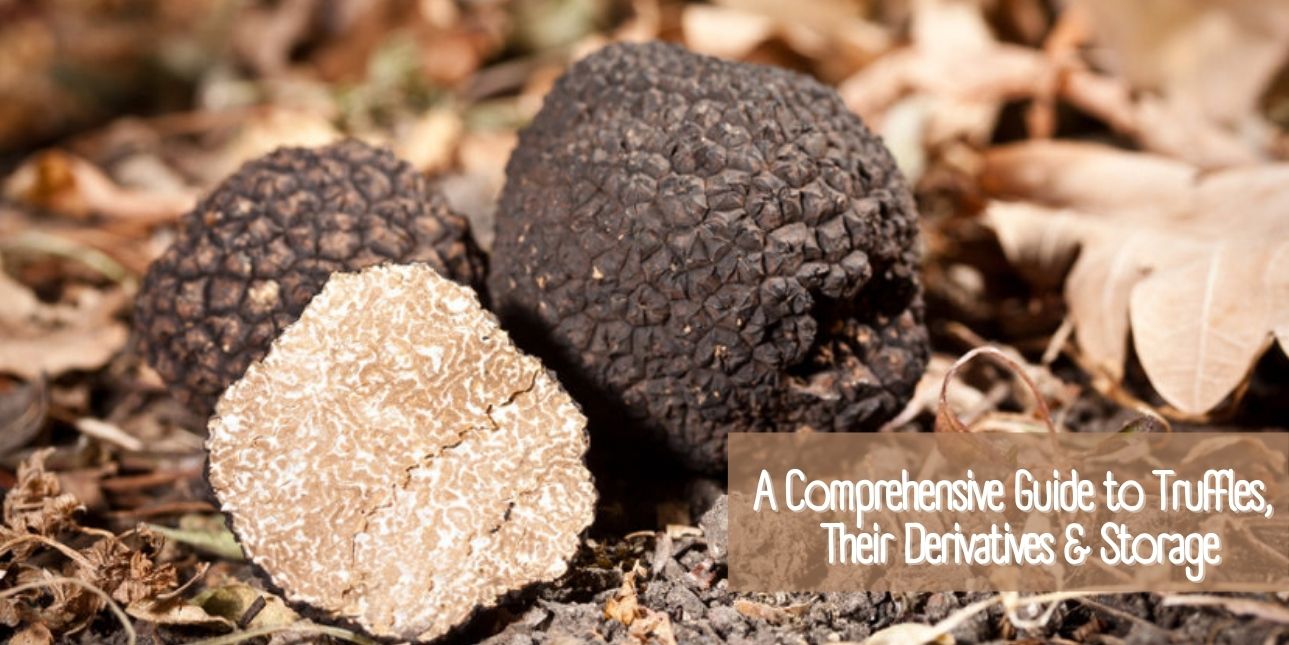
Truffles are a type of fungi that grow beneath the ground, below hardwood and broadleaf trees such as oak and hazelnut varieties. They grow in soils that are high in calcium content and are very climate-sensitive. Truffles often enter a symbiotic relationship with the trees they grow under. While the trees provide the fungi with the much-needed glucose for survival, truffles offer important minerals such as phosphorus & magnesium to the trees in return. Truffles are extremely fickle when it comes to growth patterns, and require very specific climatic conditions. They’re often found in temperate regions, and in forests that experience relatively warm daytime temperatures, followed by cool nights. Originally native to the northern regions of Italy and southern France, truffles are now cultivated in several parts of the world including the USA, Canada, Australia, New Zealand, and several European nations. There are over a couple of hundred varieties of identified truffles, however, only a handful are known to be used for culinary purposes. The most common among these are black and white truffles, used in a variety of dishes to enhance both taste and aroma.
Truffles vs. Mushrooms
It’s common for people to get confused and wonder, are truffles mushrooms? This confusion stems from the fact that they’re both varieties of fungi. However, the commonality ends there. Truffles are subterranean, while mushrooms prefer the topsoil & overgrowth over the depths of the earth. Despite thousands of varieties of mushrooms being identified, only a small percentage of that number is edible. The edible part of the mushroom is the spore-bearing unit of the fungi, also called the fruiting body. The mushroom is capable of reproducing by dispersing spores by air, water, and a variety of other methods. Edible portions of the mushrooms are visible and above ground, whereas the larger network of fungal tubules called hyphae lie beneath the surface. What are truffles made of? The answer’s straightforward - truffles too are composed of fruiting bodies. The spore-bearing portions form the edible part of the fungus that we call truffles. While mushrooms have earthy taste notes, truffles have a variety of tastes from musty to pungent & garlic-like.
The Types of Truffles
Truffles come in a variety of forms, and each of them has its distinctive features and traits that set them apart from their counterparts. Here are the most common types of truffles:
- Black Truffles: What is a black truffle? They’re some of the most commonly available varieties of truffles. Black truffles are dark-colored, harvested between November and March, and have an earthy taste. They require very mild heat to bring about their flavor when added to a dish. Black truffles are sometimes used in creating their derivatives - black truffle oil & black truffle butter.
- White Truffles: White truffles are rarer when compared to their darker siblings, and are usually available for about four months starting in January and go off the shelves sometime by the end of April. If you’ve wondered about the taste of truffles, white truffles are more aromatic and pungent. They also have a similarity to garlic and require no heat to bring out their flavor.
- Burgundy Truffles: These truffles have a reddish-black outer color and are harvested in the fall months lasting September to December. The burgundy truffle taste resembles a nutty note, coupled with earthy influence. Burgundy varieties are much milder than the white truffle, however, they’re more pungent and potent when pitted against the black truffle.
White Truffle vs. Black Truffle
Many culinarians and home cooks are often torn over the differences between white and black truffles. Apart from understanding what’s a truffle, it’s also essential to know the key differences between the two most common varieties to better use them in your kitchen. While black truffles are available for a longer period of nearly half a year, white truffles are rarer and available only for the first four months of the year. Black truffles have a mild taste profile, quite in contrast with their lighter counterpart’s pungent aromaticity. Due to their mild taste, black truffles pair perfectly well with a variety of meats such as beef, pork, or fish. They also need to be heated very mildly to bring about their rich texture and flavor. Conversely, white truffles require almost no heat and would be ruined by high temperatures. Most culinarians choose to use white truffle shavings as a garnish on dishes high in fat content, as this distributes the pungency more evenly throughout the dish.
Why Is a Truffle So Expensive?
So how much do truffles cost? Most people are taken aback when they learn of the high price tags truffles come with. The price of truffles is influenced by several factors. Due to their sensitivity to weather conditions, truffles are extremely rare and are commonly found in the wild. Despite growth and advances in the truffle farming industry, it remains a long and arduous process that can take several years to become successful. Truffles were formerly sniffed out from the ground by pigs that have a penchant for detecting them, however, this method was inefficient because the pigs often ended up eating the truffles they would find. This led to farmers training dogs in the detection of truffles, a more recent trend that is catching on fast.
A truffle orchard can be planted by injecting the spores near the roots of hardwood trees when they’re still saplings and under the right conditions. However, the success rates are still meager. The trees need to be spaced at quite a distance from each other, and truffles can take up to half a decade to become worthy of harvest. Despite all these efforts and the variables involved, truffles have incredibly short shelf lives and tend to go bad in about two weeks after harvest. These factors, combined with the waiting period for the harvest, and the overall perishability of the truffle make it one of the most expensive ingredients on the kitchen shopping list. Commercial businesses need to purchase appropriate storage equipment from a restaurant supply store to store their truffles safely, lest they accrue large and unwanted losses.
What are Truffles Used For?
Now that you are familiar with what a truffle is, it’s essential to understand its applications in a kitchen so you can serve the best delights to your customers. Truffles are commonly used in recipes that have mild, and flat taste profiles. These dishes enable the flavor of truffles to come out better and help you get a better sense of the truffle taste. These include dishes with ample amounts of cheese, cream, and potatoes. White truffle shavings taste the best when dusted over a plate of risotto, pasta, or even a white pizza. Black truffles can be used in meat-based dishes, and also pair well with eggs. On the other hand, burgundy truffles are best suited to dishes with earthy taste profiles and blend in with dishes that contain squash or pumpkin. A point to note would be that truffles don’t go well with acidic components in food, so it’s best to avoid using them in dishes that use tomatoes or citrus fruits.
Although truffles are used for creating derivatives like black truffle oil, this is, however, a small minority of the offerings on the market. Most truffle oil varieties use synthetically generated 2,4-dithiapentane- the same aromatic agent found in black truffles. This compound along with a number of other chemical agents is added to olive oil to give you a truffle-like experience.
How to Store Truffles
Truffles are extremely perishable, and you might be in for quite a loss if you fail to preserve them the right way. Here’s how you can store truffles in a simple manner:
- Refrigerators are your best bet if you intend to store truffles for a considerable period.
- Truffles usually last anywhere from one to three weeks in a fridge. If you’re operating a commercial food business, walk-in refrigerators are good options for bulk truffle storage.
- Be sure to remove the excess moisture from your truffles using a paper towel before placing them in an airtight container.
- It’s recommended that you place them on a paper towel within the container so it can absorb any residual moisture still within the truffles.
- Don’t forget to change the paper towel every 3-4 days.
- Truffles can also be stored in uncooked rice, however, this will cause the rice to absorb the truffles’ flavor, and might even make them dry by drawing out too much moisture.
The Takeaway
Truffles are some of the most treasured elements in fine dining, and they’re truly worth all the hassle - provided you know to use them right. Be sure to understand the truffle taste before you incorporate these delicious fungi into your recipes. Truffles might be delicate, but learning to store them right will allow you to make the best out of every ounce.










